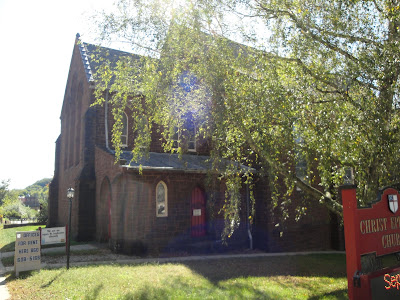 |
| Finnish-American Hall, Canterbury, CT |
My friend, Linda, and I headed to Canterbury on October 5th for the Finnish-American Market Walktober 2019 event. Later this month we will be attending a lecture on Finnish-American culture through Adventures in Lifelong Learning (ALL), at Three Rivers College. Presenter Anita Smiley will discuss Finnish immigration and the Finnish-American community she grew up in. So, we thought a trip to this market would be a good tie-in to the upcoming lecture.
 |
| Sisu Finn Soaps from Voluntown, CT |
Of course, when you are at a market, you have to spend a little money. So, I made a beeline to the display of artisan goat milk soaps. The aroma was wonderful and I finally settled on a bar of Blood Orange which has a refreshing tropical scent. You can reach Sisu Finn Soaps at sisufinnsoaps@gmail.com
 |
| Ron Angotta - AWL Woods Design |
We had a wonderful time talking with Ron Angotta who is passionate about his wood box designs. It was a tough decision, but Linda finally settled on one made with Leopardwood and a dragon fly handle. Ron uses many different varieties of both native and exotic woods.
 |
| Birch bark braiding |
We also saw ornaments and baskets made by braiding birch bark, and some beautiful handwoven scarves.
 |
| Handwoven scarves |
 |
| Homemade jams |
I bought some Lingonberry-apple jam from this couple. Lingonberries are popular in Scandinavian and Nordic countries where they are typically grown.
 |
| Scott Weeks - Hickory Forge |
In the basement kitchen, a lunch was being served consisting of meatballs, gravy, mashed potatoes and peas. Outside it looked like a tag sale area, except that Scott Weeks from Hickory Forge in Norwich, CT was set up to do a blacksmithing demonstration.
 |
| Booths were set up both indoors and outside |
Also outside was a display of Finnish-American brochures. I picked up a news bulletin from the Finnish-American Heritage Society and learned they have many gatherings focusing on Finnish food, musical instruments, crafts, and traditions. I also picked up a study guide for the Kalevala, a Finnish Epic first published in 1835, which led the way to acceptance of Finnish as the official language of Finland rather than that of occupier languages of Swedish and Russian. The Kalevala contains ancient poems of myths and rituals going back to 500 B.C. It is a source of great pride and considered a national treasure.
My final takeaway from this day trip is a Finnish word - Sisu. Sisu is an important part of Finnish culture having to do with a stoic determination to go beyond one's physical or mental capacities. It is the national character trait of stick-to-it-ivness. Taking action against the odds, with extraordinary determination, is what helps all people see and reach beyond their present-day limitations.
See books by Laura S. Pringle on Amazon
The Pringle Plan is a series of educational guides.
©2019 Laura S. Pringle. All Rights Reserved.










































